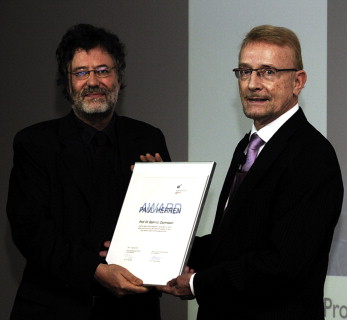Professor Bjørn Zachrisson receives the Paul Herren Award 2009
The Department of Orthodontics and Dentofacial Orthopedics, University of Bern, Switzerland, established the Paul Herren Award in memory of its former director, Professor Paul Herren. The award will be given annually to persons from the orthodontic specialty in recognition of outstanding achievements in teaching, clinical excellence, and orthodontic research.
The first Paul Herren Award was presented to Professor Bjørn Zachrisson, University of Oslo, Norway, on December 3, 2009, in Bern, in a ceremony attended by 220 Swiss colleagues.
The award committee wrote in its laudation: “Professor Zachrisson belongs, without doubt, to the most prominent orthodontists of our time. With his clinical and research work on prevention of iatrogenic damage, bracket bonding and debonding, bonded retainers, aesthetics and interdisciplinary treatment, as well as orthodontic finishing and excellence, he has inspired, influenced, and motivated generations of orthodontists and other dental specialists.”

B. F. and Helen E. Dewel Award for best clinical research article
The editorial board of the American Journal of Orthodontics & Dentofacial Orthopedics ( AJO-DO ) has announced that it will award the 2010 B. F. and Helen E. Dewel Award to Dr Kevin O’Brien, University of Manchester, United Kingdom. This award is sponsored by the AJO-DO and named in memory of longtime editor Dr B. F. “Tod” Dewel; it recognizes the best clinical research article published in the AJO-DO each year. This honor will be shared with 23 coauthors who participated in this multi-center, randomized, controlled trial using a contemporary functional appliance. The trial was funded by the United Kingdom Medical Research Council. The article, entitled “Early treatment for Class II Division 1 malocclusion with the Twin-block appliance: A multi-center, randomized, controlled trial,” was published in the May issue (O’Brien K, Wright J, Conboy F, Appelbe P, Davies L, Connolly I, et al. Am J Orthod Dentofacial Orthop 2009;135:573-9).
This large prospective clinical trial was designed to evaluate the effectiveness of early orthodontic treatment with the Twin-block appliance for the correction of Class II Division 1 malocclusions. At the start of this 10-year study, children were randomized to an early treatment group or an observation group. In an earlier article, the authors reported interim results from the first phase of the study. They showed that early treatment was effective, leading to a reduction in overjet, a small skeletal change, and an improvement in children’s self-esteem. In this new article, final results, including phase 2 treatment during adolescence, were reported.
One hundred forty-one patients completed treatment or accepted their occlusion. Those who had early treatment had more appointments, experienced longer overall treatment times, and incurred more costs than did the adolescent treatment group. Noted O’Brien, “Early treatment with the Twin-block appliance, followed by a further course of treatment in adolescence at the appropriate time, does not result in any meaningful long-term differences when compared with 1 course of treatment that starts in the late mixed or early permanent dentition. There are definite disadvantages to the 2-phase approach, including an increased burden for the patient in terms of appointments, costs, length of treatment, and an inferior final occlusal result.” This study reinforces the findings of other similar randomized controlled trials previously published in the AJO-DO . Early treatment for Class II skeletal problems is not routinely justified.
The award will be presented on Sunday, May 2, 2010, during the AJO-DO Editorial Board Breakfast at the 110th AAO Annual Session in Washington, DC.




